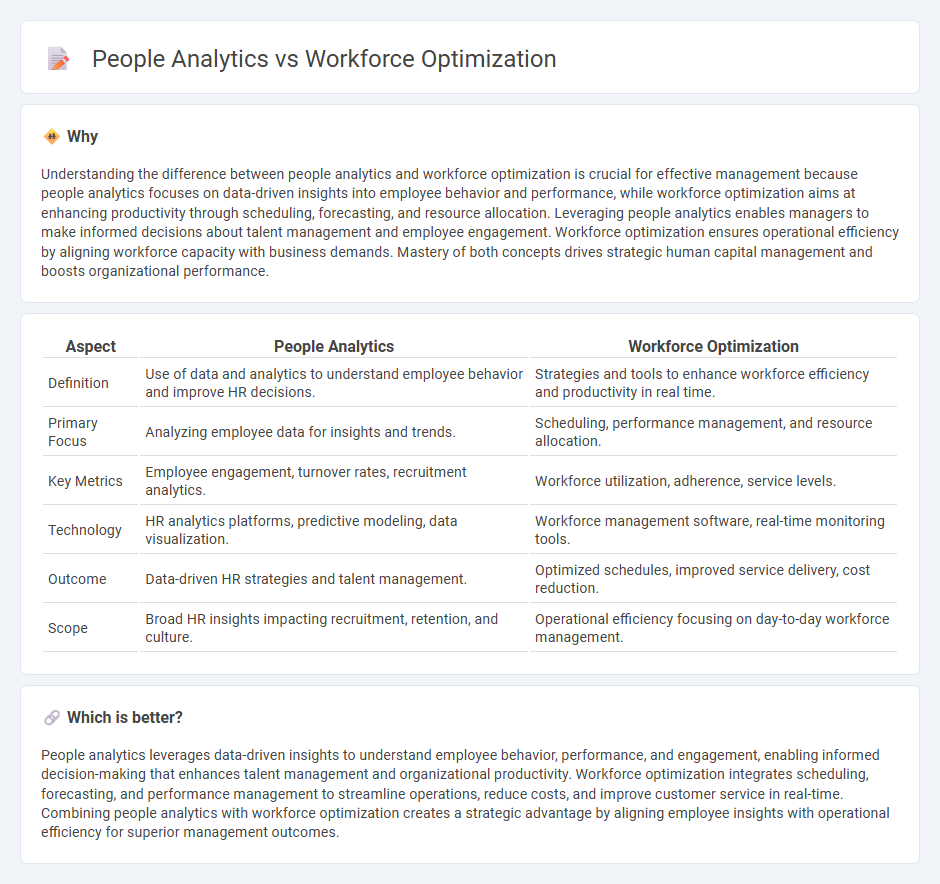
People analytics leverages data-driven insights by analyzing employee behavior, performance metrics, and engagement levels to enhance decision-making and talent management. Workforce optimization integrates these insights with operational data such as scheduling, productivity, and resource allocation to improve overall organizational efficiency. Discover how combining people analytics and workforce optimization transforms management strategies for better business outcomes.
Why it is important
Understanding the difference between people analytics and workforce optimization is crucial for effective management because people analytics focuses on data-driven insights into employee behavior and performance, while workforce optimization aims at enhancing productivity through scheduling, forecasting, and resource allocation. Leveraging people analytics enables managers to make informed decisions about talent management and employee engagement. Workforce optimization ensures operational efficiency by aligning workforce capacity with business demands. Mastery of both concepts drives strategic human capital management and boosts organizational performance.
Comparison Table
| Aspect | People Analytics | Workforce Optimization |
|---|---|---|
| Definition | Use of data and analytics to understand employee behavior and improve HR decisions. | Strategies and tools to enhance workforce efficiency and productivity in real time. |
| Primary Focus | Analyzing employee data for insights and trends. | Scheduling, performance management, and resource allocation. |
| Key Metrics | Employee engagement, turnover rates, recruitment analytics. | Workforce utilization, adherence, service levels. |
| Technology | HR analytics platforms, predictive modeling, data visualization. | Workforce management software, real-time monitoring tools. |
| Outcome | Data-driven HR strategies and talent management. | Optimized schedules, improved service delivery, cost reduction. |
| Scope | Broad HR insights impacting recruitment, retention, and culture. | Operational efficiency focusing on day-to-day workforce management. |
Which is better?
People analytics leverages data-driven insights to understand employee behavior, performance, and engagement, enabling informed decision-making that enhances talent management and organizational productivity. Workforce optimization integrates scheduling, forecasting, and performance management to streamline operations, reduce costs, and improve customer service in real-time. Combining people analytics with workforce optimization creates a strategic advantage by aligning employee insights with operational efficiency for superior management outcomes.
Connection
People analytics leverages data science to analyze employee behavior, performance, and engagement, providing actionable insights for management decisions. Workforce optimization uses these insights to enhance productivity, streamline processes, and align talent strategies with business goals. Integrating people analytics with workforce optimization drives evidence-based management and maximizes organizational effectiveness.
Key Terms
**Workforce Optimization:**
Workforce optimization integrates advanced labor forecasting, real-time performance management, and strategic scheduling to enhance employee productivity and operational efficiency. It leverages predictive analytics and automation tools to align workforce capacity with business demands, reducing costs and improving service levels. Explore how workforce optimization transforms human capital strategies to meet evolving organizational goals.
Resource Allocation
Workforce optimization utilizes resource allocation to improve productivity by matching employee skills to business demands, reducing labor costs, and enhancing operational efficiency. People analytics dives deeper into data-driven insights about employee performance, engagement, and potential, enabling strategic decisions that focus on talent development and retention. Discover how advanced resource allocation strategies in these fields can transform your workforce management.
Performance Management
Workforce optimization centers on enhancing employee productivity through strategic scheduling, workload balancing, and resource allocation, directly impacting overall operational efficiency. People analytics leverages data insights from employee behavior, engagement metrics, and performance trends to inform decision-making and tailor development programs for workforce growth. Explore how integrating these approaches revolutionizes performance management by driving informed strategies and measurable business outcomes.
Source and External Links
Your Workforce Optimization Guide For 2025 | When I Work - Workforce optimization (WFO) is a holistic approach enhancing business efficiency and employee productivity by focusing on customer-first perspectives, time management, and attendance tracking, helping businesses identify operational breakdowns and improve staffing coverage.
Workforce Optimization: The What, Why and How - Indeed - Workforce optimization improves business performance by boosting employee efficiency and effectiveness through better scheduling, training, and process automation, leading to increased productivity, reduced costs, and higher employee and customer satisfaction.
What is Workforce Optimization? - ServiceNow - Workforce optimization applies data analytics to enhance employee effectiveness and reduce costs, focusing on maximizing operational success and quality of work, especially in customer-facing industries, but applicable across many sectors.
 dowidth.com
dowidth.com